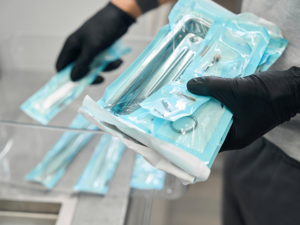
A medical device manufacturer just received an order for a high volume of surgical scissors from a hospital. The manufacturer shares the specifications with its overseas fabricator, which forges, finishes, and sterilizes the scissors. After a final visual inspection, the scissors are sealed into plastic pouches and packed into cardboard boxes.
The boxes are loaded on a cargo ship, then unloaded and transported to a distribution center, and, finally, packed into a delivery truck. By the time the scissors are delivered to the hospital, many of the plastic pouches have been punctured, torn, or popped, compromising the sterile barrier and rendering the scissors unusable. Poor packaging cost the manufacturer thousands of dollars – and its relationship with the hospital.
The manufacturer learned an important lesson the hard way: packaging can make – or quite literally break – a product. To ship products with confidence and ensure they reach their final destination unharmed, rigorous, data-driven testing using precisely engineered measurement equipment is nonnegotiable.
Common Sources of Shipping Stress
A single product may change hands dozens of times before reaching its final destination. Each day, products fly through turbulent skies, traverse pothole-filled roads, and languish in warehouses that might be hot and humid one day, and cold and dry the next. Products in transit may be subjected to:
- Drops
- Stacking compression
- Sudden acceleration or deceleration
- Sharp turns
- Sudden braking
- Extreme turbulence
- Moisture or dryness
- Intense heat or cold
There’s little that manufacturers can do to control what happens to a product once it’s been shipped. The best way to protect products as they jostle, fall, and tumble through the supply chain is to enclose them in packaging that withstands the unpredictability of transit.
What Happens When Good Products Are Poorly Packaged
Consumer HarmProducts, like medical and dental devices, must be kept in secure packaging that forms and maintains a sterile barrier. Faulty packaging can expose the device to pathogens that could cause life-threatening infections in patients. Other products – including food, beverages, and cosmetics – must also be carefully packaged to prevent contamination that could harm consumers.
Costly, Time-Consuming ReworkIf a distributor or end user receives a damaged package, they may reject the shipment. When this happens, the manufacturer is usually left holding the bag – and is often responsible for recalling the old order and shipping a new one. Depending on the product, order size, and severity of the problem, defective packaging can cost manufacturers hundreds of thousands of dollars in lost products, shipping and storage.
Reputational DamagePoor packaging can quickly sink a manufacturer’s reputation. Channel partners and consumers have little tolerance for low-quality or defective packaging. They may cut ties with anyone who sends products in packaging that can’t withstand being bumped, jostled and compacted while in transit. Companies that treat packaging like an afterthought may lose existing customers and struggle to build new professional relationships.
Protect Packages with Precise, Data-Driven Testing
Relying on feel and “eyeballing” is insufficient when it comes to testing the integrity of packaging. To ship products with confidence, manufacturers and packaging professionals need objective, quantitative data that can only be generated by precision force measurement equipment. The right equipment will reveal whether the materials, quality and durability of a package offer adequate protection – or whether further experimentation and testing are needed.
How Mark-10 Testing Equipment Can Be Used to Test the Integrity of Packaging
Manufacturers across industries have relied on Mark-10’s expertly designed and engineered force and torque measurement instruments to test their packaging since 1979. Our motorized force testers and universal testing machines can be configured to conduct a wide range of tests to validate packaging integrity, including:

- 90° peel testing of adhesive tapes or foil seals
- T-peel testing of flexible packaging materials
- 180° peel testing
- Opening force testing
- Burst testing
- Score bend testing
- Bottle cap torque testing
- Coefficient of friction testing
- Top-load testing of bottles and cartons
- Foil seal pull-off testing
The quantitative data generated by Mark-10 equipment helps manufacturers meet relevant industry standards and achieve consistency from order to order, giving them confidence in every product shipped.
To learn more, speak with a Mark-10 product expert. Our knowledgeable team members will advise you on which equipment is best suited to your unique application.

